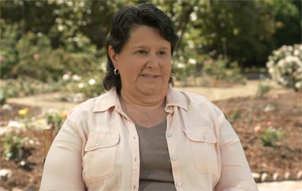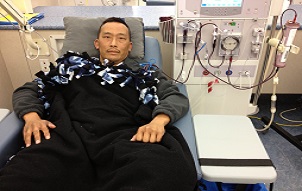Frequently Asked Questions
-
Who can be a living kidney donor?
+In order to be considered as a living kidney donor, an individual must be in overall good health, and over the age of 18 and under the age of 80. Certain medical conditions will result in a potential living donor being considered ineligible for donation, such as kidney or heart disease, uncontrolled high blood pressure, diabetes, cancer (within the last five years), and current major infections, such as HIV, Hepatitis B or Hepatitis C.
-
Do I have to be related to my recipient?
+You do not need to be related to the person to whom you wish to donate. While many transplant recipients receive a kidney donated by a blood relative, about half of all living donor kidney transplants involve a donor who is not biologically related. It is common for spouses, friends or even co-workers to offer to donate kidneys to people who are important to them. Some people step forward as “altruistic donors” to donate organs anonymously to those in need.
-
If I have a family member or friend who needs a kidney transplant, how can I help them?
+Kidney patients who are eligible for a transplant need emotional support, caregiving assistance, and potentially a living donor. If you wish to explore being a related or non-related living kidney donor, the first step is to learn more about what is involved from resources such as Living Donation California. Second, you can inform your family member or friend that you would like to be evaluated as a potential donor. The patient can then refer you to the transplant team at their hospital for evaluation.
-
How are living donors and recipients matched?
+Living kidney donors and potential recipients are matched by blood type (A, B, O, AB) and tissue typing; physical size and age are also taken into consideration. Gender and ethnicity are not factors in matching patients, although some matches are more frequent within certain ethnic groups.
-
Who pays for living donation and kidney transplants?
+Costs of the donor evaluation, surgery, hospitalization, doctors’ fees and follow-up medical visits are typically covered under the recipient’s private insurance and/or Medicare. The costs for travel expenses, lodging or other non-medical expenses are not covered. It is illegal under federal law to receive money or gifts in exchange for an organ donation and therefore, organ donors are never financially compensated.
-
What are the risks of being a living kidney donor?
+Risks to a living kidney donor during surgery are the same as any other surgery: reactions to anesthesia, bleeding, blood clots, infection and wound healing problems. Relative to many common surgeries, a nephrectomy has few complications – 95 to 96 percent of donors have no complications.
A study by John Hopkins University School of Medicine that followed 80,000 living kidney donors over a 15-year period found that there was no increase in mortality rates among donors compared to healthy people with both kidneys.
-
Will donating a kidney be painful?
+As with any surgery, pain should be expected following the operation, however, the level of pain varies from person to person. Pain is managed with medications to make the donor more comfortable.
-
How will my body work with one kidney instead of two?
+The human body functions very efficiently with just one kidney. In fact, some people are born with one kidney or lose one due to injury and are able to live full lives with little or no effect. When a person donates a kidney, the remaining kidney grows slightly larger to make up for some of the function of both kidneys.
-
Will I have a scar, and if so, what will it look like?
+In the majority of cases, the surgical removal of the donor’s kidney (called a donor nephrectomy) is done by laparoscopic surgery which involves two to three small incisions in the abdomen and one larger incision (6-9 centimeters) through which the kidney is removed. Surgery is performed under general anesthesia. In a small number of cases, a laparoscopic nephrectomy is not an option, so the surgery involves a five to seven inch incision on the side of the chest and upper abdomen.
-
After donating a kidney, how soon can I return to my normal lifestyle?
+The recovery time following surgery to donate a kidney varies from person to person. The typical hospital stay is one to four days after surgery. Most donors are able to resume their hobbies after one month and return to work within four to eight weeks, depending on the level of physical exertion required.
-
Who will cover my travel expenses and time off?
+Costs of the donor work-up, surgery, hospitalization, doctors’ fees and follow-up doctor visits are covered under the recipient’s insurance and/or Medicare. The costs for travel expenses, lodging, or other non-medical expenses are not covered and are the donor’s responsibility.
-
If I take time off from work, could I lose my job?
+California state law, SB 1304 (DeSaulnier, 2010) requires employers of any business that employs 15 or more to provide up to 30 days of paid leave for organ donation and permit employees to return to the same position or an equivalent position. Check your employer’s policy for details.
-
What happens if my remaining kidney stops working?
+For the benefit of both the donor and the recipient, potential living kidney donors undergo a very thorough psychological and medical screening to ensure they are healthy and suitable to undergo the procedure. In very rare cases, a kidney donor may experience loss of kidney function in the years following their kidney donation. Should this occur, priority is given to a prior living donor according to national organ transplant waiting list regulations.
-
Will donating a kidney affect my activities in the future?
+Some medical organizations, such as the American Academy of Sports Medicine and the American Academy of Family Physicians, suggest that a person with one kidney should refrain from sports involving high contact or frequent collisions. Individuals who participate in these sports should exercise caution, be aware of possible consequences, and wear appropriate protective equipment. Additionally, people with one kidney may be at a greater risk of high blood pressure, proteinuria (protein in the urine) and reduced kidney function.
-
For recipients, what are the advantages of a kidney transplant from a living donor versus a deceased donor?
+For someone waiting for an organ transplant, there are benefits to receiving a kidney from a living donor:
- The current wait time for a kidney transplant in California is two to ten years depending on blood type. When a living donor is available, that time can be reduced significantly.
- Often, a person waiting for a kidney transplant is kept alive through dialysis, which only does 10 to 15 percent of the work of fully functioning kidneys. People on dialysis are more susceptible to infection and other complications, must follow a restricted diet, and often feel tired or ill. Someone who receives a kidney from a living donor may spend less time on dialysis or in some cases, avoid it all together, and therefore be healthier going into surgery and have a shorter recovery.
- When a living donor is available, the surgery can be scheduled on a convenient day for the donor and recipient.
- A kidney transplanted from a living donor typically lasts 15 to 20 years, which is five years longer than a kidney from a deceased donor.
-
What is dialysis?
+Dialysis is a medical process that removes toxins and excess fluids from a patient’s blood stream when the kidneys do not function properly. There are two main types of dialysis: hemodialysis, which is performed at a dialysis clinic three times a week for three hours at a time, and peritoneal dialysis, which is done on an ongoing basis. Both are artificial means of cleansing the blood and perform only 10 to 15 percent of the work of fully functioning kidneys. As such, dialysis patients must follow a strict diet, restrict fluid intake, and often take medicine to manage blood pressure, red blood cell count and levels of minerals such as phosphorous and calcium in the blood.
-
How long does it take to be evaluated to be a living kidney donor?
+There are many steps and processes in the evaluation process for a living kidney donor. The length of time it takes to be evaluated is based on many factors, including the schedules of the hospital, potential donor and the recipient. The process typically takes two to six months for a complete work-up. Tests include:
- Tissue Typing: The donor’s blood is drawn to determine what kind of “match” exists between the donor and recipient by checking the tissue between six genetic codes (called HLA antigens) on the donor and recipient’s white blood cells. A “perfect match,” in which all six HLA antigens match, occurs only about 15 percent of the time. More commonly, one to three antigens match.
- Crossmatching is a blood test done before the transplant to determine if the potential recipient will react to the donated organ. In the event there is a “positive” crossmatch, the donor and recipient are deemed incompatible because the antibodies will immediately react against the donor’s cells and cause immediate loss of the transplant. If the crossmatch is “negative,” the transplant may proceed. A crossmatch is done early on in the work-up process and also within 48 hours of surgery.
- Antibody Screen: An antibody is a protein substance made by the body’s immune system in response to a foreign substance such as a transplanted organ, blood transfusion, virus or pregnancy. Because antibodies attack the transplanted organ, the antibody screen tests to see if there are antibodies in the recipient that react with the antigens of the donor.
- Heart Health: A chest X-ray and an electrocardiogram (EKG) screen the donor for heart and lung disease.
- Psychiatric Evaluation is given to both the donor and the recipient.
-
What are HLA Antigens? Why are these important for organ transplants?
+Human Leukocyte Antigens (abbreviated as HLAs) are proteins located on the surface of the white blood cells and other tissues in the body. An individual is born with six HLAs, inheriting a “set” of three from each parent. HLAs are able to differentiate between the body’s own cells and “non-self” cells. Cells displaying a different HLA type are identified as invaders by the body’s immune system, resulting in the “rejection” of the tissue with those cells. In the case of transplantation, this is especially important because it may lead to rejection of the transplanted organ.
As part of the work-up for a living kidney donor, the HLAs are determined so that the donated organ can be matched with a compatible recipient. The more HLA antigens two people share the more their tissue is compatible with each other and less likely the chance of rejection.
-
What is the relationship between Living Donation California & the National Kidney Registry?
+Living Donation California is an information and referral service for those considering altruistic living kidney donation. The National Kidney Registry (NKR) maintains a confidential database of medical information that makes it possible to match living donors and recipients between subscribing transplant centers.
Interested and informed individuals who complete Living Donation California’s online self-assessment may be referred to a California kidney transplant program if they are determined to be potentially eligible to be a living donor. If at the conclusion of a subsequent evaluation the transplant center approves the individual to be a living donor, the center may match the donor with one of their patients. The transplant program may also employ NKR’s proprietary technology to determine whether the donor can be matched with a recipient at another transplant program, potentially as part of a chain of transplants involving multiple transplant centers. For more information about NKR, visit www.kidneyregistry.org.




